Are those unsightly Peace Lily brown leaves affecting the aesthetics of your home? Well, we have your back with the potential causes and their solutions!
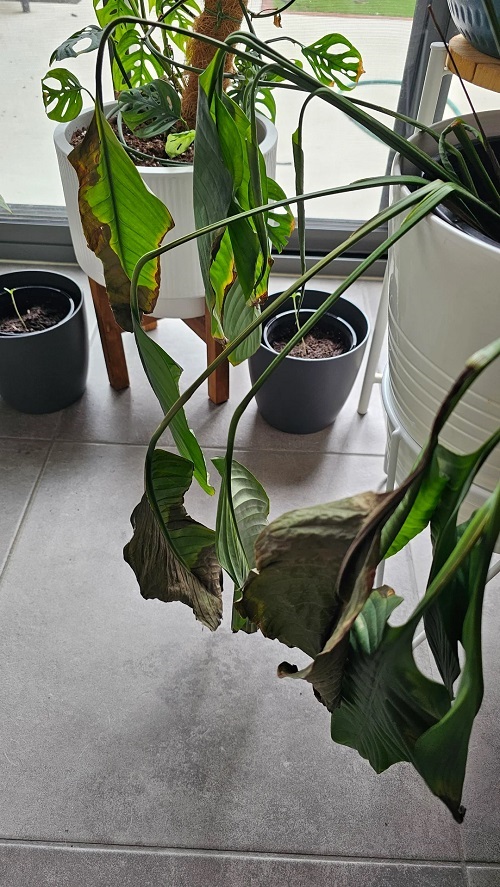
Apart from the classy aesthetics, Peace lilies are also fantastic air purifiers. Sadly, even the best plants can get a little sad sometimes. Don’t fret! This guide has all sorts of tricks to help your peace lily brown leaves revert back to their healthy state!
Reasons And Solutions Of Brown Leaves In Peace Lily
1. Too Much or Little Sun Exposure

Peace lilies need the perfect balance of sunlight, a lack of which can lead to brown spots on their foliage. Scorched, crispy edges with faded or bleached spots turning brown are primarily the signs of too much sunlight.
However, do remember that droopy leaves with dark, muddy brown spots scream a lack of enough sunlight.
How To Fix?
Relocate your peace lily to a spot with indirect light, maybe near your north-facing window or a few feet away from a brighter spot. Watch the leaf edges and adjust the plant’s position accordingly.
2. Overwatered Roots
If you find the leaves turning soft and brown, starting from the tips, it is most probably a sign of an overwatered plant. In such a case, its base might also feel mushy, and the soil emits a stale, musty odor indicative of rotting.
How To Fix?
Water when the top inch of soil feels dry to the touch. Stick your finger in the surface of the medium, if it doesn’t, it’s watering time. Water slowly and thoroughly, allowing excess water to drain freely from the pot. Soggy soil is a breeding ground for root rot, so avoid letting your peace lily sit in water.
3. Underwatered Plant
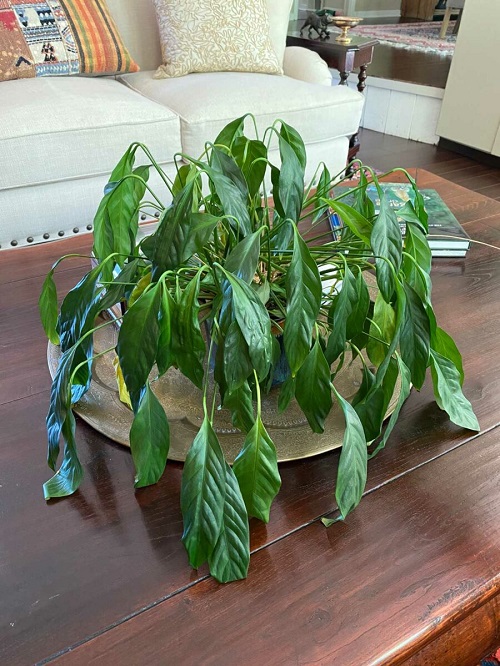
While overwatering is a common scenario, underwatering, too, can be a formidable foe. Dry and brittle leaves with brown tips and edges particularly signify underwater plants. Sometimes, even the entire leaf can eventually turn brown and crispy if the drought continues.
4. Insufficient Drainage in the Pot
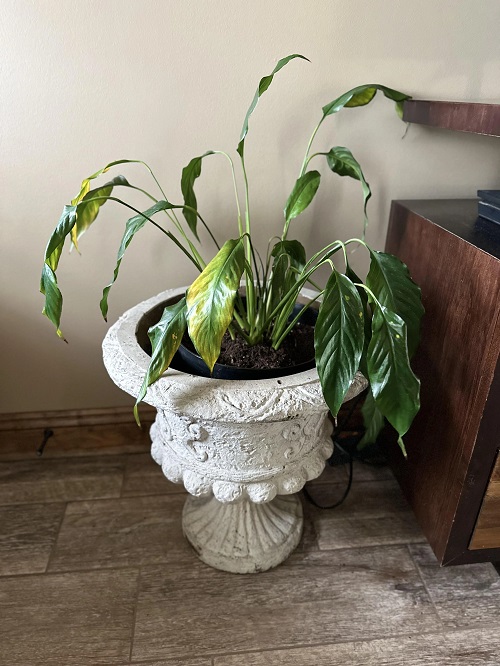
Peace lilies may love moisture, but stagnant water is a recipe for disaster. A clogged drainage hole traps water around the roots, suffocating them and ultimately turning the leaves yellow-brown.
How To Fix?
Make ample holes in the pot and maintain a weekly deep watering schedule. Saturate the medium until the water drains away from the bottom. This ensures the roots get enough water without sitting in a soggy mess. If you think the brown leaves on peace lily are due to this reason, repot your plant into a well-draining container with fresh potting mix.
5. Use of Compact or Contaminated Soil
Peace lilies prefer well-drained soil to show off their healthy, shiny foliage. Water pooling on the surface instead of seeping through indicates poor aeration and drainage. Dense, heavy soil retains too much moisture, suffocating the roots and leading to brown leaves.
This condition generally manifests as unusual patterns of discoloration on the leaves, including patches of yellow and brown.
How To Fix?
Give your peace lily a happy root home. Use a good quality, commercial potting mix specifically formulated for houseplants. These mixes are usually light and airy, allowing for proper drainage and aeration. You can go for perlite or orchid bark for added drainage.
Here Are Some Flower Varieties That Look Like Lilies
6. Fluctuations in Temperature and Humidity
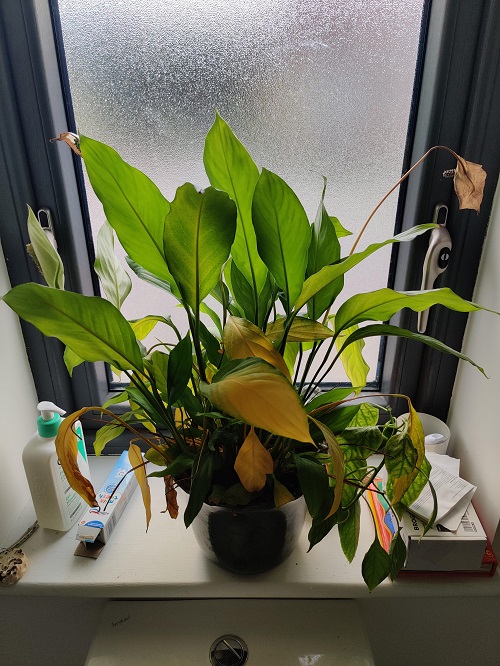
Peace lilies are adaptable, but temperature and humidity extremes can cause stress. Brown tips or edges on the leaves occur when the air is too dry or when the plants are exposed to drafts near heating systems or cold air conditioning.
How To Fix?
Maintain a stable environment with temperatures between 65-80°F or 18-26°C and humidity levels around 40-50%. If the air is too dry, use a humidifier or a pebble tray to boost humidity. You may also group the plants together to create a microclimate. Do not forget to keep them away from drafty spots.
7. Overfertilization
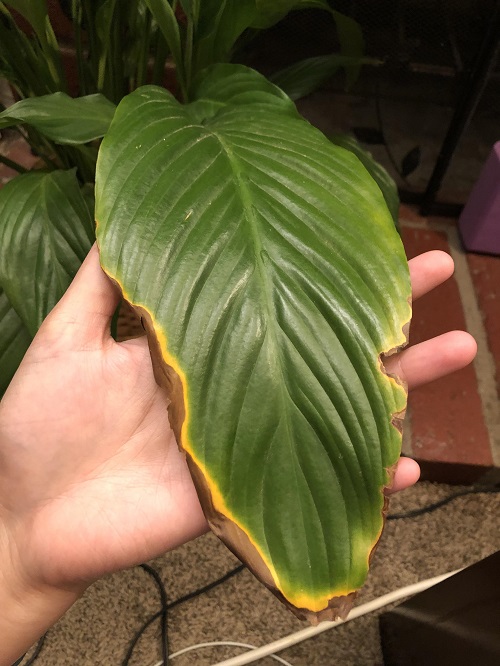
While Peace Lilies need some fertilization, they are not heavy feeders. And, if you ever end up overfeeding your plant, it will show unhappy signs such as salt buildup on the soil surface and leaf tip burn. The roots may also appear brown and slimy when removed from the pot.
How To Fix?
Fertilize sparingly during the spring and summer months every 4-6 weeks with a diluted liquid fertilizer specifically formulated for houseplants. Remember to dilute the blend to 1/4th its strength.
8. Using Hard Water
Peace lilies are pretty sensitive to minerals and salts in tap water, which appear as deposits or a white crust on the soil surface. Due to the accumulation of salts and minerals, brown leaf tips and margins may also appear.
How To Fix?
Use filtered or rainwater whenever possible. If tap water is your only option, let it sit overnight in an open container to allow chlorine to evaporate. Regularly leach the soil by watering thoroughly to flush out any accumulated salts.
9. Pest Infestation
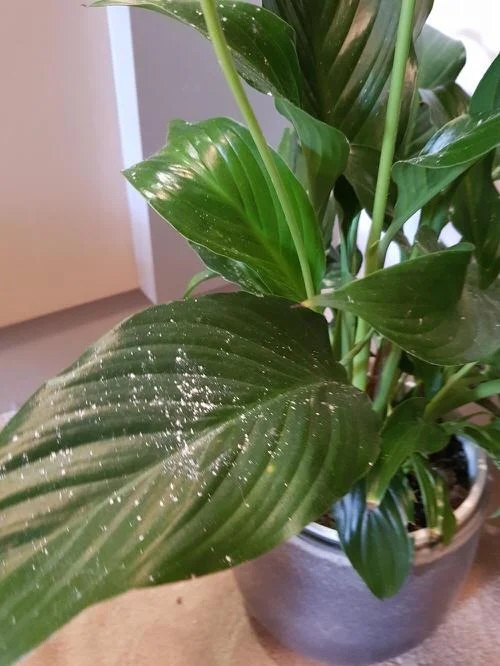
Sap-sucking insects like spider mites, mealybugs, and aphids can cause stunted growth and small, irregular brown spots on the leaves. Pests typically gather on the undersides of leaves or at leaf joints, so be mindful of that.
How To Fix?
Isolate the affected plant to prevent the spread to other indoor plants. Wipe leaves with a soft cloth dipped in soapy water or use an appropriate insecticidal soap. For severe infestations, neem oil can be an effective organic option.
What To Do With Those Brown Leaves?
Use sharp scissors to cut the brown parts off at the base, leaving the healthy bits alone. For small brown edges, snip them off at an angle. This keeps the leaf looking natural and pointy. For those with big brown edges, it’s best to remove the whole leaf. This can redirect its energy into growing nice, new green leaves.
But don’t forget the real cause—brown leaves are often a sign of something else, like too much or too little water, inadequate light, or any of the factors discussed. Fix that underlying issue, and you’ll get back those lush, healthy leaves.






